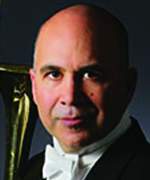Allegro
Always a surprising ride
Reflections on "The Rite of Spring" at 100
Volume 113, No. 5May, 2013
The Rite of Spring” is a composition that never loses its freshness or its avant-garde edge. I don’t find it dated in the slightest, in spite of the fact that it was written 100 years ago. My point of view is corroborated by modern audiences’ reactions to the piece as well; you can see on their faces that for some it is just as unnerving and cacophonous as it was on first hearing long ago in Paris. I have a lot of personal connections to this piece, maybe more than just about any other symphonic work I have performed.
My first “Rite of Spring” experience was a concert I did with the Santa Rosa Symphony in California when I was 15 years old, for which I played the bass trumpet part. Coreck Brown was the conductor, and I found myself terrified just to count it. After the first rehearsal I went back home to listen over and over to a recording of the piece and decided that I needed to feel the rhythms, above all else, especially in the “Danse Sacrale.” Counting it did not work nearly as well as just getting the rhythms in my ears and body.
Next was a performance at the Curtis Institute where I again played bass trumpet, this time with Rafael Fruhbeck de Burgos conducting. That was a far more enjoyable concert because I felt I was genuinely getting the rhythms and felt more at ease on the bass trumpet too. I could step away from my playing long enough to appreciate the piece itself. Now it became terrifying for the right reasons – its relentless rhythms and sheer animalism.
Numerous performances followed, many of them good experiences. My personal relationship with the “Rite” started to evolve further when my son Joseph decided that he needed to be born during a snowstorm on the first night of a “Rite of Spring” series at the Philharmonic in February 1988. In the afternoon, when it was clear I had the choice of either missing my son’s arrival or playing the “Rite,” we got hold of my great teacher and colleague Glenn Dodson from the Philadelphia Orchestra, who happened to have the evening off. He zipped up the Jersey Turnpike through the snow in his Porsche 911, and just managed to make it in time to play for me on the 2 p.m. matinee.
That may have been one of the few performances of the “Rite” that my son has since missed and I began to see the “Rite of Spring” through his eyes. Joseph was first exposed to this piece as a small child while watching Disney’s “Fantasia” from 1940, with Stokowski conducting the Philadelphia Orchestra. I remember my son running around the room singing the themes from the “Rite” and pretending he was a dinosaur. We decided to buy him the scores of several of Stravinsky’s compositions when he was 5 or 6 years old because he said he might like to become a conductor some day. I sat down with him and taught him the conductor’s beat patterns for the “Rite” with the music playing loudly in the background. I was pretty shocked, a short time later, to hear him solfeging the entire opening of the “Rite of Spring,” from the opening bassoon line to the bass clarinet part. Then he learned to conduct the “Danse Sacrale” pretty much by memory. Even for a small child, the effect of this piece was enormous. Seeing it through my son’s eyes made it exciting all over again.
I think at this moment in my career I have performed the “Rite of Spring” close to 100 times. My favorite of all those concerts, without a doubt, was the most recent series with the New York Philharmonic with Alan Gilbert in 2012. Maestro Gilbert took the slow movements sometimes quite a bit slower than I had encountered, so the rhythms were, if possible, even more insanely repetitive and foreboding. The fast sections were at times utterly savage. It was a very disturbing, electrifying experience and the audience collectively jumped to its feet.
As time has gone by, I have found that I have been able to let go and sink into the drama and fury of the piece, but only by knowing it all by feel. The notes come a lot easier now, so I can put all the counting aside and let the “Rite” take over while we play. No matter how many times I get to play this composition in the future, I know that each time will always be a surprising, upsetting and a wild ride.
Joseph Alessi is the principal trombonist of the New York Philharmonic


